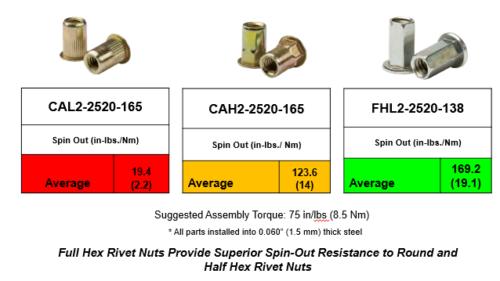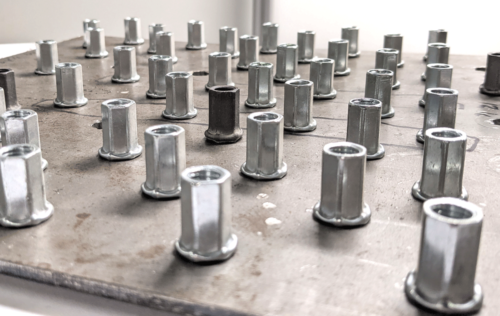When most people think of rivet nuts, they think of little, round body fasteners that are easy to install and have a wide variety of uses.
In reality, we should begin to think of them in hexagonal form. Hex body rivet nuts are amongst the strongest, best-performing rivet nuts on the market today.
Hex body rivet nuts come in the same material as round body (aluminum, steel, stainless steel, etc.), they can have a large flange or small flange, and, like their round-body counterparts, can possess special features such as a mechanical lock to keep joints secure in high-vibration environments, or a watertight gasket to keep dirt, water, dust, or other potential corrosives from degrading the joint over time.
Most importantly, hex body rivet nuts out perform their round body brothers in just about every performance metric available. Spin-out, torque out, push out and pull out. Look at the graphic below to see the overwhelming spin-out performance boost offered when switching to a half-hex or full-hex rivet nut body style. The hex body rivet nut is almost 10 times stronger than a typical, knurled round body rivet nut when installed in the same material. Due to their larger cross-sectional areas, full-hex rivet nut body styles also have increased thread performance as well as enhanced pull-out/push-out resistances when compared to their round-body and half-hex counterparts.
The hex body rivet nut is almost 10 times stronger than a typical, knurled round body rivet nut when installed in the same material. Due to their larger cross-sectional areas, full-hex rivet nut body styles also have increased thread performance as well as enhanced pull-out/push-out resistances when compared to their round-body and half-hex counterparts.

Testing hex body rivet nuts in 1/4-inch thick steel for an agriculture equipment manufacturer
Although hex body rivet nuts can be installed in any material, steel or harder materials will provide the best mechanical properties for improved performance. Just keep in mind the potential for galvanic corrosion when choosing certain materials for your rivet nut versus the base material it’s installing in.
The only caveat with hex-body style rivet nuts? You need a hex hole to install them with. For many manufacturers, making hex holes quickly and reliably (or, sometimes, even at all) can be a complicated task and the main barrier of entry, but it’s a process that in the long run will make that manufacturer’s products perform better when using rivet nuts. Many manufacturers are making the switch, knowing the performance will last.
Half-hex body rivet nuts are available as well, but they too need to be installed in hex holes. The prevailing advice is to go with full hex due to the previously-mentioned structural benefits provided by the larger cross sectional area. However, half-hex rivet nuts maintain many of the enhanced spin-out benefits at a lighter weight and at a lower cost.
Sherex’s FHL, FHK Series and large style LRGH Series rivet nuts are becoming more and more popular and used by many manufactures in automotive, heavy truck, and construction and agriculture equipment industries.
It’s really quite simple, if you can produce a hex hole, you should be using a hex body rivet nut. For more information about hex body rivet nuts and using them in your applications, contact us!






1 Comment
PENCOM
This blog is hands down the most accurate information about Hex body rivet nuts. Yes, one can use the flanged head of the rivet to support the hole and boost its resistance. I think it is pretty ideal for load-bearing applications.